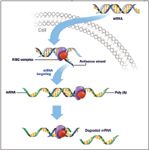Tomorrow's Drugs
Have you heard the rumors that all the drugs have already been discovered? Well, forget it. Maybe some of the low-hanging fruit is gone-but in the last few years, science has opened up thousands of new targets, while new technologies have made it possible to treat disease in unprecedented ways.
Have you heard the rumors that all the drugs have already been discovered? Well, forget it. Maybe some of the low-hanging fruit is gone—but in the last few years, science has opened up thousands of new targets, while new technologies have made it possible to treat disease in unprecedented ways.
In the next few pages, the Pharm Exec staff profiles some of the hottest therapies and smartest technologies that have caught our eye—from RNAi therapies to genetic editing to therapies that stop disease before it starts. Taken together, they form a vision for the next generation of drugs, one that will transform the industry (and the face of healthcare) in the decades to come.
THE REAPPEARING ACT
Inhibition of BMP and GDF proteins offers a twist on the science—and a way to reverse disease
"Accentuate the positive," went the old song. "Eliminate the negative." Who knew it was describing two alternative strategies for encouraging the growth of bone and tissue?
Two key families of proteins are involved in creating the structure of the body during embryonic development and the regulation of growth: the growth and differentiation factor (GDF) and the bone morphogenic proteins (BMP). So far, there are at least 15 known types of both GDF and BMP, each with the ability to stimulate cell growth in a particular way and at a particular time.

Steven Ertel of Acceleron Pharma
These proteins are endlessly active and control cell growth and death. Take the case of bone: Sometimes, the molecules in BMP send a signal to the osteoblast cells, which carry out the growing of bone. Other times, BMP sends a signal to the osteoclasts, which are responsible for breaking down bone.
Many companies have tried to tap into the lucrative markets of osteoporosis and cancer-related bone loss by manipulating GDF and BMP. (Currently, most treatments only slow down bone loss, rather than rebuild bone.) For example, Medtronic has a product called Infuse, which is genetically engineered BMP: when administered locally, it signals osteoblasts to get to work. It's a very effective option for a narrow slice of patients, such as those undergoing spinal-fusion surgeries.
However, successive attempts to develop drugs to treat blockbuster conditions like osteoporosis and cancer-related bone loss have failed, because companies have not been able to figure out how to develop a therapeutic that could be administered systemically. (Most recently, Ortho Biotech terminated a BMP-7 program licensed from Curis for tissue repair in renal disease.)
Part of the problem is that most companies have overlooked attempts to "eliminate the negative." "Rather than triggering osteoblasts to grow bone, the less developed area of biology is recognizing that there are also molecules that send signals to osteoblasts to say 'Stop, you've built enough bone,'" said Steven Ertel, vice president of business development at Acceleron Pharma.
Acceleron is pioneering BMP and GDF inhibition, and working on the "off" switch for osteoblasts. "Think of the two ways to move a car," said Ertel. "You can hit the gas pedal, or you can take your foot off the brake. Instead of giving a positive growth factor, you inhibit the negative growth factor."
The company's lead candidate, ACE-011, is in Phase I for postmenopausal osteoporosis, according to Wolters Kluwer. So far, the results are positive.
"The early data based on mouse models of ACE-011 are interesting—and actually quite intriguing," says Louise Perkins, research director of the Multiple Myeloma Research Foundation. "There appears to be a huge amount of bone growth. If this agent works in [humans], it could bring a change in the quality of life in multiple myeloma patients."
Acceleron is developing several other therapies based on this underlying science, including ACE-031 for muscle growth. This therapy will seek to grow muscle in patients by turning off myostatin, or GDF-8, and holds promise to treat ALS (amyotrophic lateral sclerosis) and muscular dystrophy. In this category, it will face stiff competition, with Wyeth and Amgen investing their own research muscle in these promising processes. –JOANNA BREITSTEIN
ANTIBODIES' NEW RIVAL
Adnectins—the fast and mean disease-fighting machine
Monoclonal antibodies and drugs like Avastin and Herceptin have radically changed the treatment landscape. Targeted protein therapeutics are the fastest-growing segment of the biopharmaceutical market, with $17 billion in sales last year. But as much as these compounds have advanced the state of care, says Davinder Gill, senior director of biologic therapeutics for Wyeth Research, there are still some unanswered questions. Asks Gill, "Shouldn't antibodies work better? Cost less? Be easier to manufacture? I mean, is this the best we can do?"
Today, researchers like Gill are looking into protein-scaffold technologies as a next-generation platform to engineer high-science drugs. "Think of it like origami," says Gill. "You start with a sheet of paper, but then can fold it in many ways. Each shape represents a different function. But that piece of paper is like a template that we can use repeatedly to develop drugs against multiple targets."
Of the scaffolds under research, one of the most promising is adnectins. Adnectins, shaped like the part of an antibody that binds targets, are composed of fibronectin (a human protein that binds to different types of molecular entities). Adnexus Therapeutics, a privately held 40-person shop based in Waltham, MA, has built its research pipeline on this technology and is working to engineer amino-acid sequences to target specific medical conditions.
The company recently signed an agreement with Bristol-Myers Squibb to develop their lead oncologic candidate, Angiocept (CT-322), which is set to enter Phase II trials in late 2007. Angiocept works somewhat like Avastin in that it blocks new blood vessels from forming and supplying tumors with the nutrients to grow. However, Avastin targets just VEGF-A, while Angiocept targets VEGF-A, VEGF-C, and VEGF-D, which may heal patients more completely.
Indeed, the ability to bind to multiple targets means that adnectins offer hope in treating more complex diseases. "For 20 years, we've been trying to figure out how to get an antibody to hit more than one target," says Adnexus CEO John Mendlein. "There are few examples of this because it goes against nature's original design, which is to make an antibody bind to only one thing."
The most promising benefits of this scaffold, however, may be commercial, not clinical. Because adnectins are smaller than antibodies—Gill says they are closer to the "speedboats" of small molecules, compared with the "cruise ships" of large molecules—they are easier to handle. For instance, Adnexus plans to manufacture the proteins in E. coli, a much cheaper method of manufacturer than the one for Avastin, which is produced in Chinese hamster ovary cells.
The company also sees the potential for rapid screening of possible adnectin candidates. Using a proprietary technology, the company can generate trillions of versions of a biologic in a single sample, then, in Mendlein's metaphor, "fish" in it using the target as bait. "It's like a Google search engine for finding a pharmaceutical. We make all these different variations of adnectin and then find the right one that has the affinity, selectivity, immunogenicity, and manufacturing properties that we believe will confer an advantage in the marketplace."
Additional protein-scaffold technologies are in the works. They include compounds built on single-domain antibodies, tetranectins, small modular immunopharmaceuticals, A-domain proteins, ankyrin repeat proteins, and lipocalins. –JOANNA BREITSTEIN
THE 411 ON GLIALS
How does an asthma drug become a medication for neuropathic pain? Alchemy, recycling, or simply smart science?
For a long time, it was assumed that neurons were the only type of cells responsible for the development and maintenance of neuropathic pain. The glial cells surrounding the neurons were disregarded as little more than "housekeepers" providing support to the neurons.
But then Linda Watkins, a professor of neuroscience at the University of Colorado in Boulder, observed something else going on. That something, she believed, was glial activity.

Avigen CEO Kenneth Chahine
Watkins' laboratory was among the first to demonstrate that glia—cells formerly thought of simply as the "glue" that holds the brain together—enhance the neurotransmitters that relay pain information to the spinal cord. Even more striking, as Watkins and her collaborator Steven Maier wrote, they "release substances that increase the excitability of pain-responsive neurons in the spinal cord. These substances, called pro-inflammatory cytokines, create and maintain exaggerated or pathological pain responses. Blocking the activation of glia reduces pro-inflammatory cytokines and reverses pathological pain."
Watkins had basically made a link in the brain between pain and inflammation. "The hypothesis then was if you could reverse glial attenuation, you could reduce or reverse neuropathic pain," says Michael Coffee, CBO of Avigen, a California biopharmaceutical company.
Watkins and others were working with IL-10, a classic reversal agent of inflammation. It was potent, but it could be used only intrathecally, as an injection into the spinal canal, a major drawback.
"Still, we knew what was happening," says Coffee. "So our team said, 'Let's look at the structure, and let's look for oral agents that have a structure and activity in the literature of glial attenuation.'"
What they found was ibudilast, a PDE inhibitor developed by Kyorin Japan for bronchial asthma and recently approved to treat dizziness secondary to chronic cerebral stroke.
"It was probably not a great product," says Coffee. "It never reached very large sales. And they didn't notice that it had any utility in pain because the doses were higher than the dose they were using in asthma."
Nonetheless, they deemed the molecule a good fit. "It can be given by mouth only once or twice a day," says Avigen CEO Kenneth Chahine. "It is fast-acting in the animal models of pain studied to date, does not sedate recipients, and does not require dose titration."
Ibudilast is a glial attenuator that, according to the company, suppresses pro-inflammatory cytokines IL-1 beta, TNF alpha, and IL-6, and may regulate the anti-inflammatory cytokine IL-10.
The first clinical study of ibudilast is under way in Australia—a Phase IIa trial, because the company can take advantage of safety data collected in Japan. Australia was ideal for the trial because of that country's mutual-recognition agreement with Japan. "It's considered a product that does not require an Investigational New Drug Application (IND). You can go right into the clinic," says Coffee. "In parallel, we're working toward filing a US IND, but rather than it necessarily all being sequential, we decided to go ahead."
Avigen hopes to obtain indications for ibudilast in opiate withdrawal—it is in late-stage discussions with the National Institute on Drug Abuse—and for chemotherapeutically induced neuropathic pain. –MARYLYN DONAHUE
HEALTHY HEARTS
A cardiovascular drug company builds stronger hearts with new blood vessels
The idea came as Thomas Stegmann walked down a hospital corridor in Fulda, Germany, after performing a triple-bypass on a patient with severe coronary artery disease. It was surgery he had performed countless times before, but this time Stegmann was struck by a thought, inspired by an article by Harvard's Judah Folkman on the use of anti-angiogenesis to halt tumor growth.
He liked the approach as a solution to an oncologist's problem. But he was a cardiologist, and saw the concepts in the article as a potential application to heart disease as well. "What the tumor researchers do not want [the growth of the new blood cells] would be very much desired by our patients who suffer from narrowed, calcified, occluded vessels," he wrote later, describing the "a-ha" moment.

Dan Montano, CEO of CardioVascular BioTherapeutics
"Stegmann developed this treatment with his own money to prove that he could grow blood vessels—and he did it," says Dan Montano, chief executive officer of CardioVascular BioTherapeutics, the company that is now developing the Stegmann's discovery.
The treatment uses fibroblast growth factor 1 (FGFR1), a protein that the body naturally creates. CardioVascular BioTherapeutics concentrates the protein and delivers FGFR1 directly into the heart, setting off an angiogenic effect.
In Phase I, the treatment was delivered surgically through a small incision in the chest. Going forward, the drug will be administered with a catheter, much like an angioplasty. The treatment consists of one injection per area. A person with, say, four blockages might need four injections, each in a different area. Using the catheter, patients can get the treatment and be out of the hospital in one day. The angiogenesis process takes approximately 12 weeks.
"The majority of the patients had miraculous recoveries," says Dave Balekdjian of the Bruckner Group, which has consulted with CardioVascular BioTherapeutics. "It's one thing to get a treatment and live longer, but it's another to return them to the quality of life they were used to before they became ill."
To date, there have been no known side effects or safety issues, probably due to the fact that the protein is injected in a relatively small quantity and is injected directly into the blockage. According to research, the body clears the protein within six hours.
"Normally, people wouldn't be getting excited about a drug that is just hitting Phase II, but the difference is that the drug has been dosed in more than 70 patients, and there are long-term outcomes data," Balekdjian says. The company can image the growth of new arteries and see the physical evidence of angiogenesis with before-and-after pictures.
CardioVascular BioTherapeutics seems to be in the lead in bringing this treatment to market, but it's not alone. Business Week recently reported that close to 700 angiogenesis-based drugs were in development. Many are for cardiac care, but other areas under consideration include wound healing, eripheral arterial disease, chronic back pain, and stroke. Stegmann also hopes that FGFR1 will lead to medical treatments for neurological diseases such as smyotrophic lateral sclerosis, multiple sclerosis, Parkinson's disease, and spinal cord injury. –GEORGE KORONEOS
SUGAR RUSH
A new technology may revolutionize the generic and biosimilar markets
We're living in the protein decade, and pharma's big recent developments have been so focused on strings of amino acids that it's easy to forget that they're not all there is to life—and disease.
What else is there? How about sugars? All human cells are covered with complex mixes of sugars, which play a major role in controlling biological processes. Even the protein drugs that have transformed the pharma world are mostly, strictly speaking, glycoproteins—combinations of proteins and sugars. Every bit as important as to health as DNA and proteins are, sugars play a major role in the cause and treatment of cancer and infections, as well as cardiovascular, inflammatory, and Alzheimer's diseases.

Craig Wheeler, CEO of Momenta
But they're not easy to study. Where DNA has four building blocks and proteins, 20, complex sugars have 48. So a single five-unit chain (out of the 150 or so different sorts found on the surface of a protein) might have more than 250 million different combinations. Sugars routinely come in complex mixtures, and unlike, say, DNA, they can't be amplified to increase sample size to make them easier to get at.
But in 1999, a team of Massachusetts Institute of Technology (MIT) biologists, chemists, and computer scientists defied conventional wisdom, cobbling together a novel technology from their diverse toolkits. It's a three-part process of near-endless elimination. Techniques using enzymes and other chemicals break down the sugar's myriad branches and chains into manageable sections. Hardware, including mass spectrometry and nuclear magnetic resonance, turns its high-tech gaze on these sections, collecting, collating, and refining data about it. Bioinformatics, mathematical modeling, and other software run all this information through the system and spit out the solution—the complex sugar's unique structure and sequence. `
Now that the MITers had this breakthrough, what would they do it? The answer came in 2002 with the start up of Momenta Pharmaceuticals. "I call our company an upside-down biotech," said Craig Wheeler, president and CEO. "We have our set of tools—our new lens into biology—to understand these mixtures."
The company is operating on a three-part strategy, using its technology first to produce generics of complex drugs (its initial product, a generic version of Sanofi-Aventis' Lovenox, a big-selling heparin-class drug used to prevent blood clots, is expected to launch late this year or early next); then to improve on them (as the company is doing with a new, rationally designed heparin); and finally to create new drugs (Momenta is currently working on a targeted sugar drug that slows tumor growth and speeds cell death in cancers).
Banking as it is on follow-on biologics as the key to its short-term success, Momenta has followed the congressional debate over legislation authorizing FDA to approve biosimilars. Wheeler has pow-wowed with agency officials to unlock the secrets of the company's novel methodology, because it has unique tools to establish bioequivalence and other criteria. If all goes to plan, Momenta could do a kind of end run around the knotty debates over validation, efficacy, and safety of biogenerics. Wheeler proposes to verify his products through cheap, quick chemical analysis rather than expensive, lengthy clinical trials. If he's right, Momenta can rev up the engine and start plucking the high-hanging fruit. –WALTER ARMSTRONG
NO RAIN ON RNAi PARADE
It's still a few years before RNAi sizzles onto the scene, but biotechs and Big Pharma are placing their bets on these nucleotides
William Shakespeare first penned the advice, "Don't shoot the messenger." But today, pharma companies are aiming their guns to do just that and, in the process, to bring about a new way to conquer many complex diseases.
Messenger RNA, or mRNA, is the first step in translating DNA into proteins. mRNA brings genetic information to the rRNA (ribosomal RNA) complex, which forms the amino acid chains that make up proteins. These proteins are then responsible for carrying out everyday cellular processes, like converting glucose into energy.

Drugmakers seek to mimic the bodys natural RNAi process to stop disease. Researchers inject double-stranded RNA into cells, where it bonds with the bodys silencing complex. It then attaches to target mRNA strands and destroys them.
Cells constantly make mRNA—but not all mRNA reaches its destination. Often, a cell spots a gene that it chooses not to express, such as a gene from a virus. In these cases, the gene is instead silenced through a process called RNA interference, or RNAi.
The process typically works well. But sometimes, cells don't recognize mutated genes. When that happens, the mRNA ferries genetic information to the rRNA and allows for the expression of the genes for cancer and lupus and all sorts of other diseases.
For years, Big Pharma has tried to stop diseases by destroying the proteins made from bad genes, primarily through monoclonal antibodies like Avastin. But these antibodies aren't easy to produce. And what's more, new research shows that the body may be fighting the treatment it's receiving. Monoclonal antibodies can cause the body to produce more unwanted proteins, says Steven Quay, CEO and president of Nastech Pharmaceuticals. That's because a cell may ratchet up production of malignant proteins to compensate for the ones that are being destroyed.
But a growing crop of biotechs are showing a new direction in research by trying to stop the protein from being made in the first place. They want to use the body's natural silencing mechanism to get rid of the mRNA strands that code for disease.
At the heart of that silencing mechanism is double-stranded RNA, or dsRNA, that helps the cell recognize "bad" mRNA and vaporize it. Companies have already figured out how to engineer dsRNA—but delivering the molecules to cells has proved a big thorn in developers' sides.
"I suspect that we will be working on optimizing delivery over a long period of time," said Alnylam Pharmaceuticals CEO John Maraganore.
dsRNA is a very charged molecule, which presents a problem. The polarity of the dsRNA is at odds with the cell membrane, making it tough for the molecule to push through. "The best analogy is the oil-and-water challenge," said Maraganore. "You have to get from the water side, which is where the RNA molecule would like to live, to another water side through this oil layer."
To solve the problem, Maraganore says Alnylam is following the grease trail by using liposome technology to put the dsRNA in what amounts to a microscopic ball of fat, getting rid of the polarity issues involved in crossing the cell membrane. The company's formula ALN-RSV01 is about to enter Phase II studies for respiratory syncytial virus (RSV), which is the leading cause of US pediatric hospitalization and causes lower-respiratory-tract infections.
Alnylam's drug would directly interfere with the virus' ability to reproduce by stopping its genetic material from being translated into proteins. "We can generate a very potent antiviral with this technology that goes after the virus itself," said Maraganore.
Besides the RSV formula, Alnylam believes its RNAi technology can treat hypocholesterolemia, liver cancer, Parkinson's Disease, and cystic fibrosis.
Several other companies are exploring additional approaches, most notably Sirna and Merck. Their wet macular degeneration drug, Sirna-027, is about to enter Phase II. Kylin Therapeutics recently bought a delivery system called pRNA—"packaging" RNA complex—which allows dsRNA to pass through the cell membrane. Nastech Pharmaceuticals' delivery system attaches peptides to the dsRNA. "The peptides will make cells drink in the liquid containing the dsRNA, maximizing the amount that infiltrates the cells," Quay explained.
However, companies haven't yet solved the problem that's plagued monoclonal antibodies—formidable production costs. dsRNA molecules are several times heavier than the traditional small molecules and, thus, more expensive to make. That's where the partnership advantage comes in. Alnylam's currently playing prom queen, with recent partnerships with Roche and Novartis. Merck bought RNAi-based biotech Sirna for $1.1 billion in 2006. AstraZeneca and Silence Therapeutics have formed an RNAi-based bond as well, though AZ is currently tight-lipped about specific targets. Kylin and Nastech are still shopping around, but both hope to get into the market soon. –ORIANA SCHWINDT
THE "GENE-IE" IN THE BOTTLE
Genetic editing just might grant great wishes in the treatment of modern disease
Think of it as the ultimate step in moving treatment upstream: reprogramming the genome itself. The evolving field known as genetic editing is showing promise as the future means of treating cancer, sickle-cell anemia, and certain forms of immune-deficiency disease.
At the heart of the process are molecules called zinc finger DNA-binding proteins (ZFPs). These naturally occurring proteins are transcription factors; that is, they regulate how DNA behaves. And the ZPFs can be engineered to perform different functions.
"Different functional domains can be attached to the ZFP to create proteins with different functions," said Elizabeth Wolffe, PhD, spokeswoman for California-based Sangamo BioSciences. "One can add a transcriptional activator or repressor domain to make a ZFP transcription factor [ZFP TF] that can be used to regulate a gene's expression up or down; or one can attach a nuclease domain to make a ZFP nuclease [ZNF] that can cut DNA at a specified site in the genome. We then use the cell's natural DNA-repair mechanism to drive a process of disruption, correction, or DNA addition, depending on what we want to do."
"The advantage in gene editing is that you're relying on the native machinery of the cell, with no enhancers," said Elazar Rabbani, founder and chairman of New York–based Enzo Biochem, which holds several patents in gene editing. "Once the gene has been successfully edited, it lasts for the lifetime of the cell."
The earliest uses of gene editing will probably treat cells outside the body. "Our initial therapeutic applications of our ZFN technology are focused on diseases of blood and the immune system," says Wolffe. "For example, HIV—in which we are disrupting the CCR5 receptor in T cells. In this application, cells will be removed from the patient, modified ex vivo using our ZFNs, expanded and qualified, and returned to the body."
Sangamo expects to initiate a Phase I trial of the process this year. Based on earlier studies by other groups, Wolffe estimates that treatment can make T cells permanently resistant to HIV for the life of the cells—a year to 18 months. "We have shown that the T cells have a selective survival advantage in the presence of HIV," she says. "One other important note is that the ZFNs only need to be present in the cell transiently to have a permanent effect. We have also demonstrated that these ZFNs can be used in stem cells and, thus, would be expected to have a far longer-term effect, as all the progeny of these stem cells would be modified."
Coming up behind the HIV treatment in Sangamo's pipeline is a therapy for glioblastoma, a brain cancer. Here, the strategy is to disrupt the glucocorticoid receptor in T cells that can kill glioblastoma cancer cells. The engineered cells—not the patient's own—will be injected into the brain in the presence of glucocorticoids to suppress rejection.
Genetic editing won't be cheap. But Rabbani stands by the technology. "I wouldn't call it expensive," he said. "Especially when the progeny of the cell can go on forever. I believe that whole-gene manipulation actually is one of the most promising approaches for people with genetic diseases like cancer." –CAROLYNNE VAN HOUTEN
FDA Grants Priority Review to Regeneron’s Eylea for Macular Edema Following Retinal Vein Occlusion
April 18th 2025Regulatory action was based on data from the Phase III QUASAR trial, which demonstrated that Eylea HD dosed every eight weeks achieved non-inferior visual acuity outcomes compared to Eylea in patients with macular edema following retinal vein occlusion.
Addressing Disparities in Psoriasis Trials: Takeda's Strategies for Inclusivity in Clinical Research
April 14th 2025LaShell Robinson, Head of Global Feasibility and Trial Equity at Takeda, speaks about the company's strategies to engage patients in underrepresented populations in its phase III psoriasis trials.
New Insights Into T Cell Exhaustion and Inflammation in Long COVID
April 17th 2025Nigel McCracken, chief operating officer, Virax Biolabs, discusses new findings that reveal altered cytokine activity and evidence of T cell exhaustion in long COVID patients, providing deeper insight into post-infection immune disruption.
Key Findings of the NIAGARA and HIMALAYA Trials
November 8th 2024In this episode of the Pharmaceutical Executive podcast, Shubh Goel, head of immuno-oncology, gastrointestinal tumors, US oncology business unit, AstraZeneca, discusses the findings of the NIAGARA trial in bladder cancer and the significance of the five-year overall survival data from the HIMALAYA trial, particularly the long-term efficacy of the STRIDE regimen for unresectable liver cancer.
Amgen’s Imdelltra Demonstrates Significant Overall Survival Improvement in Small Cell Lung Cancer
April 16th 2025In the Phase III DeLLphi-304 trial, patients with small cell lung cancer administered Imdelltra achieved a statistically significant and clinically meaningful improvement in overall survival compared to standard-of-care chemotherapy.
